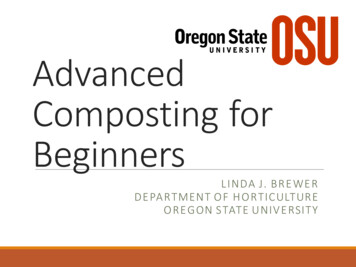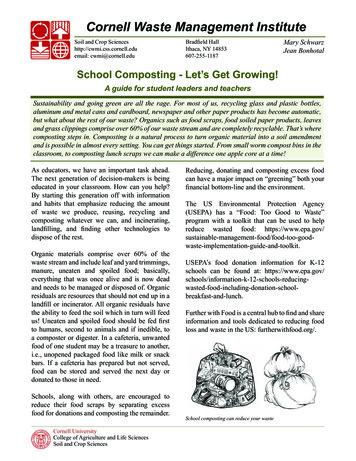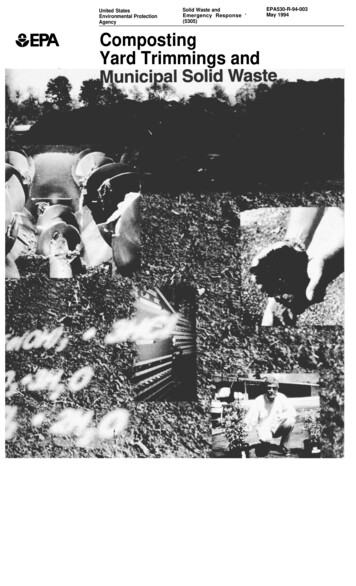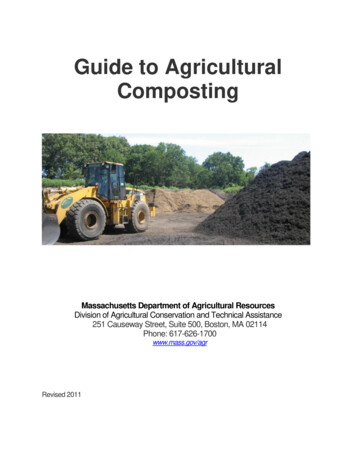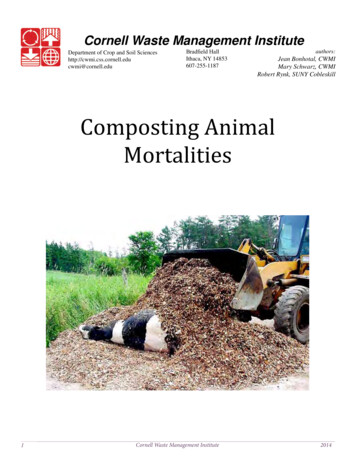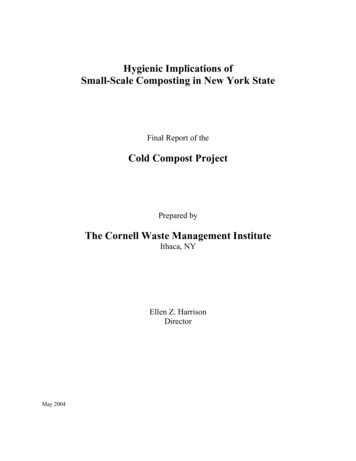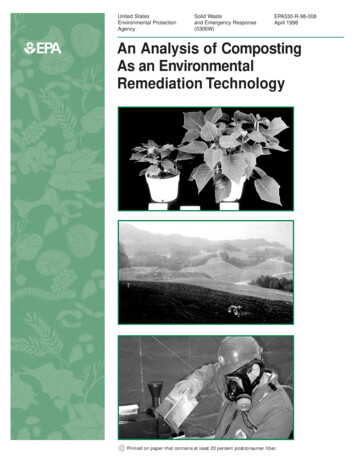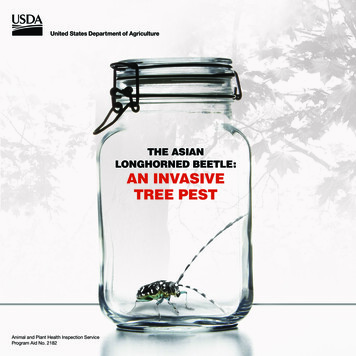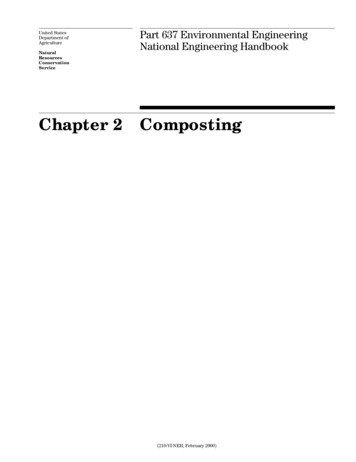
Transcription
United StatesDepartment rt 637 Environmental EngineeringNational Engineering HandbookChapter 2 Composting(210-VI-NEH, February 2000)
Chapter 2CompostingPart 637National Engineering HandbookIssued February 2000The United States Department of Agriculture (USDA) prohibits discrimination in all its programs and activities on the basis of race, color, nationalorigin, gender, religion, age, disability, political beliefs, sexual orientation,and marital or family status. (Not all prohibited bases apply to all programs.) Persons with disabilities who require alternative means for communication of program information (Braille, large print, audiotape, etc.) shouldcontact USDA’s TARGET Center at (202) 720-2600 (voice and TDD).To file a complaint, write USDA, Director, Office of Civil Rights, Room326W, Whitten Building, 14th and Independence Avenue, SW, Washington,DC 20250-9410 or call (202)720-5964 (voice or TDD). USDA is an equalemployment opportunity provider and employer.(210-VI-NEH, February 2000)
Chapter 2CompostingAcknowledgmentsPart 637National Engineering HandbookChapter 2, Composting, was prepared by Robert E. Graves, professor,Agricultural and Biological Engineering Department, The PennsylvaniaState University, and Gwendolyn M. Hattemer, engineering project associate, Agricultural and Biological Engineering Department, The Pennsylvania State University. Donald Stettler, environmental engineer, NaturalResources Conservation Service, National Water and Climate Center, Portland, Oregon, coordinated the project. This project was originally conceivedby James N. Krider, national environmental engineer, NRCS, Washington,DC (retired) working with Dana Chapman of The Pennsylvania StateUniversity and NRCS (retired).The major NRCS participates in the review of this document from its inception were Barry Kitzner, national enviornmental engineer, Washington,DC, David C. Moffitt, water quality specialist, Fort Worth, Texas; VictorW.E. Payne (retired), and Frank Geter (retired).The final edit, graphic production, and publication formatting were provided by Mary R. Mattinson, editor; Wendy Pierce, illustrator; and SuziSelf, editorial assistant, NRCS National Produdction Services, Fort Worth,Texas.(210-VI-NEH, February 2000)2–i
Chapter 22–iiComposting(210-VI-NEH,February2000)Part 637National Engineering Handbook
Chapter 2CompostingChapter 2Contents:Composting637.0200Part 637National Engineering HandbookIntroduction2–1(a) Definition of composting . 2–1(b) Composting in the United States . 2–1(c) General procedure . 2–1637.0201Principles of composting2–2(a) General background . 2–2(b) Composting process . 2–2(c) Microbiology . 2–4(d) Chemical transformations . 2–6637.0202Design of compost mixtures2–11(a) Components of compost mix . 2–11(b) Typical raw material . 2–12(c) Determination of the compost recipe . 2–13637.0203Monitoring and parameter adjustment2–17(a) Temperature . 2–17(b) Odor management . 2–18(c) Moisture . 2–18(d) Oxygen and carbon dioxide . 2–19(e) Monitoring equipment . 2–19637.0204Odor generation2–20637.0205Additives, inoculums, alth risks of a composting operation2–24(a) Bioaerosols . 2–24637.0208Aeration requirements(210-VI-NEH,February2000)2–252–iii
Chapter 2CompostingPart 637National Engineering Handbook637.0209—Analysis of raw materials and compost2–28(a) Determining moisture content . 2–29(b) Bulk density . 2–30(c) pH and soluble salts . 2–30(d) Particle size distribution . 2–31(e) Organic matter content . 2–31(f) Substrate degradability . 2–31(g) Compost quality . 2–31(h) Determination of compost stability . 2–33637.0210Composting methods2–36(a) Passive composting piles . 2–36(b) Windrow . 2–37(c) Passively aerated windrows . 2–37(d) Aerated static pile . 2–38(e) In-vessel systems . 2–39(f) Comparison of composting methods . 2–40(g) Controlled microbial composting . 2–42637.0211Dead animal composting2–44(a) General . 2–44(b) Dead poultry and small animal composting . 2–46(c) Dead swine and large animal composting . 2–47637.0212Operational costs2–50(a) Availability and price of raw material . 2–50(b) Quantity and price of land available for the composting operation . 2–50(c) Estimated costs of operation/production . 2–50(d) Pre-startup cost . 2–51(e) Material handling . 2–51(f) Monitoring . 2–51(g) Operations after completion of composting . 2–51637.0213Compost end use2–52(a) Land application . 2–52(b) Marketing considerations . (210-VI-NEH,February2000)
Chapter 2Part 637National Engineering HandbookCompostingAppendixesAppendix 2A Common Raw Materials for Farm Composting . 2A–1Appendix 2B Testing Material on the Farm . 2B–1TablesTable 2–1Dewar self-heating method for determining2–34compost maturityTable 2–2Stability of compost based on carbon dioxide2–34respired during incubationTable 2–3Volatile organic acids as an indicator of compost2–35instabilityTable 2–4Phytotoxicity as an indicator of compost stability2–35Table 2–5Mortality rates and design carcass weights for2–47determining the size of a dead swine composting facilityTable 2–6Mix for composting dead swine with sawdust2–48Table 2–7Mix for composting dead swine with broiler litter2–48using sawdust/straw as a carbon source and bulkingagentFiguresFigure 2–1Compost temperature ranges2–2Figure 2–2Bacteria2–4Figure 2–3Fungi2–5Figure 2–4Actinomycetes2–5Figure 2–5Higher organisms2–5Figure 2–6Passive compost pile2–36Figure 2–7Windrow method2–37Figure 2–8Passive aerated windrow2–38(210-VI-NEH,February2000)2–v
Chapter 2Part 637National Engineering HandbookCompostingFigure 2–9Aerated static pile2–38Figure 2–10Bin2–39Figure 2–11Rectangular agitated bed system2–39Figure 2–12In-vessel silo2–39Figure 2–13Rotating tube composter2–40Figure 2–14Dead bird composter2–45Figure 2–15Dead bird bin composting schematic2–45Examples Example 2–1 Determining the proportion of materials needed to2–14develop a mix based on the C:N ratioExample 2–2 Determining the size of a dead swine –49
Chapter 2Chapter2CompostingComposting637.0200 Introduction(a) Definition of compostingComposting is the controlled aerobic biological decomposition of organic matter into a stable, humuslike product called compost. It is essentially the sameprocess as natural decomposition except that it isenhanced and accelerated by mixing organic wastewith other ingredients to optimize microbial growth.The potential benefits of composting manure andother organic wastes are improved manure handling;reduced odor, fly, and other vector problems; andreduced weed seeds and pathogens. Land appliedcompost improves soil fertility, tilth, and water holding capacity. It is also free of offensive odors and canbe stored for extended periods. These qualities make itsuitable for use on the farm or for sale.Composting is easily adapted to agricultural operations because farms generally produce suitableamounts and types of waste for composting, haveadequate land, will benefit from the application ofcompost to the soil, and have the necessary equipmentalready available.Part 637National Engineering Handbookcrop residue. It provides a means of developing anorganic source of fertilizer or soil conditioner. Because composting is suited to a wide range of materials, it is possible for a composting operation to workin cooperation with other farms, municipalities, andindustry to compost their organic wastes, such asmanure from horse race tracks, food processingwastes, or yard trimmings.(c) General procedureThe principal elements in planning a compost facilityinclude performing site investigations and developingthe recipe design, facility design, waste utilizationplan, and an operation and maintenance plan. Becausecomposting is a relatively fexible process, it is necessary to decide among alternative methods, locations,and materials. The decision depends on the management and economic aspects of the farm as well as onthe physical limitations of the site. The planner needsto present the landowner with the different alternatives so that the owner can make the final decision.(b) Composting in the UnitedStatesComposting is more prevalent in the United States inresponse to concerns about agricultural pollution andthe encroachment of the urban population in ruralareas. The availability of cost-sharing to fundcomposting facilities, particularly in some criticalwatersheds, has also driven the growth of composting.The Natural Resources Conservation Service helpsfarmers to design composting facilities as a part of awaste management system. Composting is used as atreatment component to convert manure and otherorganic material into a more environmentally stableproduct.Composting is an alternative to more commonly usedmethods of managing manure and other organicwastes, such as poultry or livestock mortalities and(210-VI-NEH, February 2000)2–1
Part 637National Engineering HandbookComposting637.0201 Principles ofcomposting(a) General backgroundComposting is the process by which various aerobicmicro-organisms decompose raw organic material toobtain energy and material they need for growth andreproduction. The stable by-products of this decomposition, the biomass of both dead and living microorganisms, and the undegradable parts of the rawmaterial make up the end product that is called compost.The organisms responsible for composting requirecertain nutritional and environmental conditions tosurvive and function. They require adequate amountsof macro- and micro-nutrients, oxygen, and water.These organisms experience optimal growth rates onlywithin certain temperature and pH ranges.(b) Composting processThe composting process is carried out by a diversepopulation of predominantly aerobic micro-organismsthat decompose organic material in order to grow andreproduce. The activity of these micro-organisms isencouraged through management of the carbon-tonitrogen (C:N) ratio, oxygen supply, moisture content,temperature, and pH of the compost pile. Properlymanaged composting increases the rate of naturaldecomposition and generates sufficient heat to destroyweed seeds, pathogens, and fly larvae.The composting process can be divided into two mainperiods: (1) active composting and (2) curing. Activecomposting is the period of vigorous microbial activityduring which readily degradable material is decomposed as well as some of the more decay-resistantmaterial, such as cellulose. Curing follows activecomposting and is characterized by a lower level ofmicrobial activity and the further decomposition of theproducts of the active composting stage. When curinghas reached its final stage, the compost is said to bestabilized.The compost pile passes through a wide range oftemperatures over the course of the active compostingperiod. As the temperature varies, conditions becomeunsuitable for some micro-organisms while at thesame time become ideal for others. The activecomposting period has three temperature ranges.These ranges are defined by the types of micro-organisms that dominate the pile during those temperatures(fig. 2–1) and are called psychrophilic, mesophilic, andthermophilic. Psychrophilic temperatures are generally defined as those below 50 degrees Fahrenheit,mesophilic between 50 and 105 degrees Fahrenheit,and thermophilic above 105 degrees Fahrenheit.Defining these temperature ranges does not meanmicro-organisms found in the pile during the mesophilic stage are not found during the psychrophilic orthermophilic stage. Rather, these ranges are defined tomake a rough delineation between temperatures atwhich certain classes of micro-organisms have peakgrowth rates and efficiencies. For example, mesophilicorganisms may inhabit the pile in the thermophilic orpsychrophilic temperature ranges, but will not dominate the microbial population because they are notfunctioning at optimal levels.The initial stage of composting is marked by eitherpsychrophilic or mesophilic temperatures dependingon the ambient temperature and the temperatures ofthe compost mix material. A short lag period is typicalat the start of the composting process before thetemperature begins to rise rapidly. This lag period isFigure 2–1Compost temperature rangesHeatingTemperature FChapter 2–2(210-VI-NEH, February 2000)Substratedepletion
Chapter 2Part 637National Engineering HandbookCompostingthe time necessary for the development of the microbial population. As the microbial population begins todegrade the most readily degradable material and thepopulation increases, the heat generated by the microbial activity is trapped by the self-insulating compostmaterial. As the heat within the pile accumulates, thetemperature of the compost pile begins to rise. Thetemperature continues to increase steadily through thepsychrophilic and mesophilic temperature ranges asthe microbial population increases and diversifies.Depending on the operation, the compost pile typicallytakes from 2 to 3 days to increase beyond mesophilictemperatures and reach the thermophilic stage ofcomposting.As the pile temperatures increase into the thermophilic range, the pile becomes inhabited by a diversepopulation of micro-organisms operating at peakgrowth and efficiency. This intense microbial activitysustains the vigorous heating that is necessary for thedestruction of pathogens, fly larvae, and weed seeds.The diversity of the microbial population also allowsthe decomposition of a wide range of material fromsimple, easily degradable material to more complex,decay resistant matter, such as cellulose.The temperatures continue to rise and peak at about130 to 160 degrees Fahrenheit. Once this peak isreached, microbial activity begins to decrease inresponse to a depletion in readily degradable materialand oxygen or to the excessively high temperature thatis detrimental to their function. Micro-organismsdegrade material by moving soluble componentsthrough their body walls as is done for simple compounds or by using extracellular enzymes to break thematerial down before it is taken into the cell body. Ifthe temperature becomes too high, the enzymes responsible for the breakdown denature and becomenonfunctional so that the micro-organisms cannot getthe nutrition they need to survive. Elevated temperature may not be lethal for all micro-organisms, but mayaffect their efficiency and further contribute to thedecrease in microbial activity. Still other micro-organisms form spores in response to excessive heating.Spores are the inactive form that some micro-organisms take to protect themselves from conditionsadverse to survival, such as heat and lack of moisture.These spores germinate once more favorable conditions return.As microbial activity decreases, more heat is lost fromthe pile than is generated, and the pile begins to cool.As the temperature cools from thermophilic levels,different micro-organisms reinhabit the pile by migrating from cooler spots while spores germinate as conditions become more suitable for survival. These microorganisms serve to continue the decomposition process. The compost pile remains in the thermophilicrange from 10 to 60 days, depending on the operation.Once the temperature decreases to below 105 degreesFahrenheit, the curing period may begin or the pilemay be aerated to reactivate active composting.At no set point is active composting determined to becomplete. It is usually considered complete when thepile conditions are such that microbial activity can notincrease enough to reheat the pile. This generallyhappens when the temperature has decreased tobelow 105 degrees Fahrenheit. Although microbialactivity is not as intense and most of the organicmaterial has already been degraded, curing is animportant part of the composting process.Curing is marked by a lower level of microbial activityand is responsible for stabilizing the products resultingfrom active composting period. Stabilization includesfurther decomposition of organic acids and decayresistant compounds, the formation of humic compounds, and the formation of nitrate-nitrogen. Anotherbenefit of curing is that certain fungi begin to inhabitthe pile and contribute to the disease suppressantqualities of the compost. Because microbial activityhas decreased and is operating at a lower level, littleheat is generated and the pile temperature continuesto decrease or remains at a low level. Proper management of moisture and oxygen is still required duringthe curing period to maintain microbial activity. Management during the curing period is also required toensure that the pile is not recontaminated with weedseeds. This may require covering or relocating thecuring piles to reduce the potential for recontamination.The reactions that take place during curing are relatively slow and, as such, require adequate time. Thelength of the curing period varies with the type ofoperation, the length of the active composting period,and the intended end use of the compost. Short, activecomposting periods require extended curing periodsto allow for sufficient decomposition and stabilization.(210-VI-NEH, February 2000)2–3
Chapter 2Part 637National Engineering HandbookCompostingCompost that will be used for sensitive end-uses, suchas application to sensitive crops or in potting media,also requires an extended curing period. Curing isgenerally considered complete when the pile afterrepeated mixings returns to ambient temperature. It isimportant to distinguish between cooling that is aresult of sufficient curing and cooling that is a result ofinadequate oxygen supply or moisture content. Curinggenerally lasts from 1 to 6 months.(c) MicrobiologyA variety of microbial populations develops in response to the different levels of temperature, moisture, oxygen, and pH within a compost pile. This microbial diversity enables the composting process tocontinue despite the constantly changing environmental and nutritional conditions within the pile. Themicro-organisms responsible for composting degradea broad range of compounds from amino acids andsimple sugars to complex proteins and carbohydrates.This results in a thorough degradation of the compostmaterial. Temperature levels and available food supplygenerally have the greatest influence in determiningwhat class and species of organisms make up themicrobial population at a particular time.Decomposition proceeds rapidly in the initial stages ofcomposting because of the abundant supply of readilydegradable material. The material is characterized by alow molecular weight and simple chemical structure.It is water soluble and can pass easily through the cellwall of the organisms, which allows it to be metabolized by a broad range of nonspecialized organisms.Micro-organisms that inhabit a compost pile are inthree classes: bacteria, fungi, and actinomycetes, ahigher form of bacteria. They can be anaerobes, aerobes, or facultative anaerobes. Strict anaerobes do notuse oxygen and will die if exposed to oxygen. Aerobesuse oxygen, and facultative anaerobes use oxygen if itis available, but can function without it.The micro-organisms within a compost pile can bepsychrophilic, mesophilic, or thermophilic dependingon the temperature range within which they experience optimal growth rates. The psychrophilic temperature range is defined as being below 50 degrees Fahrenheit, mesophilic between 50 and 105 degrees Fahrenheit, and thermophilic between 105 and 160 degreesFahrenheit.(1) BacteriaBacteria (fig. 2–2) are small, simple organisms presentprimarily during the early stages of the compostingperiod. They are responsible for much of the initialdecomposition and include a wide range of organismsthat can survive in many different environmentalconditions. Although they are small relative to fungiand actinomycetes, they are present in significantlygreater numbers.Bacteria are fast decomposers. They stabilize mostreadily available nutrients, such as simple sugars, aswell as digest the products of fungal decomposition.Some bacteria can degrade cellulose.Figure 2–2As the readily degradable material is consumed andthe supply diminishes, more complex, less degradablematerial begins to be decomposed. This material ischaracterized by a high molecular weight, polymeric(long chain) chemical structure that cannot passdirectly into the cells. The material must be brokendown into smaller components through the action ofextracellular enzymes. Not all of the micro-organismspresent in the compost pile can produce these enzymes, particularly simple organisms, such as bacteria.Such decomposition requires more specialized organisms, such as fungi. After the polymeric material ishydrolyzed into smaller components by these specialized organisms, the resulting fragments can then beused by the nonspecialized organisms.2–4(210-VI-NEH, February 2000)Bacteria
Chapter 2Part 637National Engineering HandbookCompostingBacteria function optimally within a pH range of 6 to7.5 and are less tolerant of low moisture conditionsthan other types of micro-organisms. Some bacteriaform endospores that enable them to withstand unfavorable environmental conditions, such as high temperature or low moisture. When the environmentbecomes more favorable for survival, the endosporesgerminate and the bacteria become active again. Thisfeature of certain bacteria helps to continue thecomposting process during the cooling phase thatfollows peak thermophilic temperatures.(2) FungiFungi (fig 2–3) are larger organisms than bacteria.They form networks of individual cells in strandscalled filaments. Fungi tend to be present in the laterstages of composting because of the nature of thematerial they decompose. Most fungi decay woodysubstances and other decay-resistant material, such aswaxes, proteins, hemicelluloses, lignin, and pectin.Fungi are less sensitive to environments with lowmoisture and pH than bacteria, but because most fungiare obligate aerobes (require oxygen to grow), theyhave a lower tolerance for low-oxygen environmentsthan bacteria. Fungi also cannot survive above atemperature of 140 degrees Fahrenheit.Figure 2–3FungiFigure 2–4ActinomycetesFigure 2–5Higher organismsConsidering that fungi cannot survive in temperaturesgreater than 140 degrees Fahrenheit and that they areresponsible for much of the decay of resistant materialindicates that excessive temperatures are detrimentalto the composting process in terms of complete degradation. Therefore, while high temperature levels aredesirable for pathogen destruction, they must becontrolled to reduce the destruction of beneficialorganisms and its subsequent effect on the completionof decomposition.(3) ActinomycetesThe actinomycetes (fig. 2–4) are the third major classof micro-organisms that inhabit a compost pile. Actinomycetes are technically bacteria because of theirstructure and size, but are similar to fungi in that theyform filaments and are able to use a variety of substrates. Actinomycetes can degrade organic acids,sugars, starches, hemicelluloses, celluloses, proteins,polypeptides, amino acids, and even lignins. They alsoproduce extracellular proteases and can lyse (disintegrate or dissolve) other bacteria. Actinomycetes aremore prevalent in the later stages of composting whenmost of the easily degradable compounds have beenProtoza(210-VI-NEH, February 2000)Rotifer2–5
Chapter 2degraded, the moisture levels have decreased, and thepH has become less acidic.(4) Higher organismsHigher organisms (fig 2–5) begin to invade the compost pile once the pile temperatures cool to suitablelevels. These organisms include protozoa, rotifers, andnematodes. They consume the bacterial and fungalbiomass and aid in the degradation of lignins andpectins. These higher organisms contribute to thedisease suppressive qualities of the compost.(d) Chemical transformationsDuring the composting process, micro-organismsdegrade the raw material of the compost mix to synthesize new cellular material and to obtain the energyfor these catabolic processes. Several chemical transformations take place as complex compounds arebroken down into simpler ones and then synthesizedinto new complex compounds.Before the micro-organisms can synthesize new cellular material, they require sufficient energy for theseprocesses. The two possible modes of energy yieldingmetabolism for heterotrophic micro-organisms arerespiration and fermentation.Respiration can be either aerobic or anaerobic. Inaerobic respiration, the aerobic micro-organisms usemolecular oxygen, O2, to liberate the bulk of the energy from the carbon source, producing carbon dioxide and water in the process (see equation 2–1).C, O, 4 H O2 CO2 2H2O Energy [2–1][]This conversion is not achieved through a singlereaction, but through a series of reactions. Thesereactions serve not only to liberate significant quantities of energy, but also to form a large number oforganic intermediates that serve as starting points forother synthetic reactions.Aerobic respiration is preferred over anaerobic respiration and fermentation for composting because it ismore efficient, generates more energy, operates athigher temperatures, and does not produce the samequantity of odorous compounds. Aerobes can also usea greater variety of organic compounds as a source ofenergy that results in more complete degradation andstabilization of the compost material.2–6Part 637National Engineering HandbookCompostingIn anaerobic respiration, the micro-organisms useelectron acceptors other than O2, such as nitrates(NO3–), sulfates (SO42–), and carbonates (CO32–) toobtain energy. Their use of these alternate electronacceptors in the energy-yielding metabolism producesodorous or undesirable compounds, such as hydrogensulfide (H2S) and methane (CH3). Anaerobic respiration also leads to the formation of organic acid intermediates that tend to accumulate and are detrimentalto aerobic micro-organisms. Aerobic respiration alsoforms organic acid intermediates, but these intermediates are readily consumed by subsequent reactions sothat they do not pose as significant a potential forodors as in anaerobic respiration.Fermentation is the simplest means of energy generation. It does not require oxygen and is quite inefficient.Most of the carbon decomposed through fermentationis converted to end-products, not cell substituents,while liberating only a small amount of energy.Unassimilated protein as nitrogenous organic residueis broken down to obtain the nitrogen necessary forthe synthesis of cellular material in heterotrophicmi
Part 637 Environmental Engineering National Engineering Handbook Chapter 2 Composting. Part 637 National Engineering Handbook Chapter 2 Composting (210-VI-NEH, February 2000) . 637.0200 Introduction (a) Definition of composting Composting is the controlled aerobic biological de-composition of organic matter into a stable, humus-
